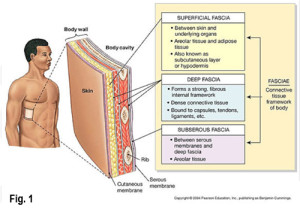Fascia. This word is thrown around a lot, but the full extent of the functionality of fascia is often overlooked. The basic function of fascia is to line every muscle and organ of the body (similar to a glad wrapping effect) to provide stability, connectivity, attachments and separation.
Separation is one of the most important functions of fascia. Muscles are made up of many tiny fibres and as each muscle in the body contracts, they slide along surrounding muscles. If you had two pieces of string and you caused frictions between them, eventually each strand of string would fray. So if fascia didn’t exist, there would be no barrier between each of the muscles which would result in muscular tears and severe discomfort.
So if fascia is such an amazing structure, why do we as Myotherapists spend so much of our time treating it? Well fascia regenerates as we are sedentary (most commonly asleep) at an incredible rate. Meaning if we don’t keep certain areas mobile, they will become fascially restricted due fascia regenerating between and attaching to neighbouring muscles resulting in a decrease in range of motion and in extreme cases, immobility.

How can we reduce the likelihood of fascial tension then? Well there are several ways, but most of the treatment methods revolve around mobility of the muscles and the surrounding fascia. Motion is lotion. As Myotherapists, we use techniques such as cupping, manual techniques, RockTape, stretching and more to help reduce any fascial abnormalities.
If you’re keen to know more about fascia and you’re not too phased by dissection of bodies and cadavers, watch this video by Gil Hedley titled The Fuzz where he shows you how fascia can become intertwined throughout surrounding muscles and cause restrictions. – https://www.youtube.com/watch?v=BdRqLrCF_Ys



